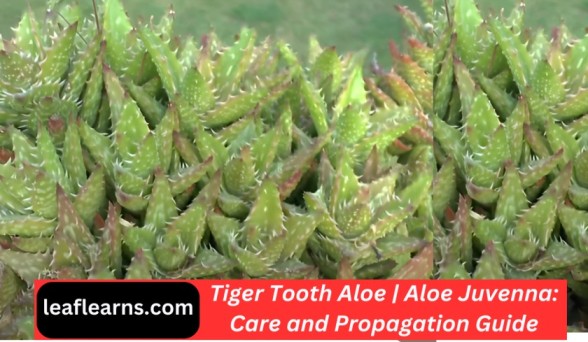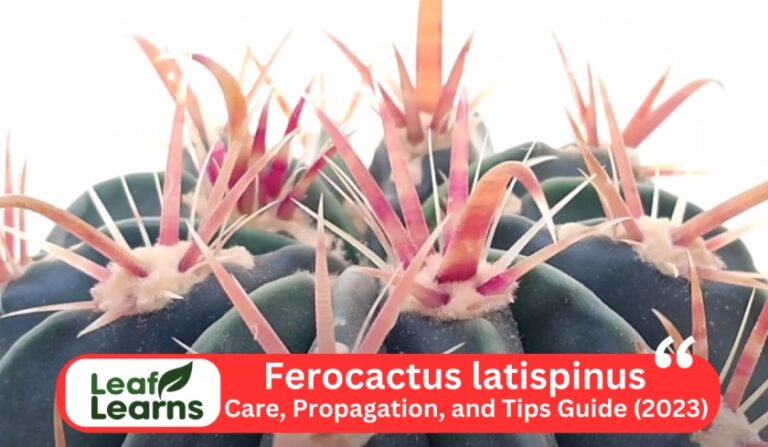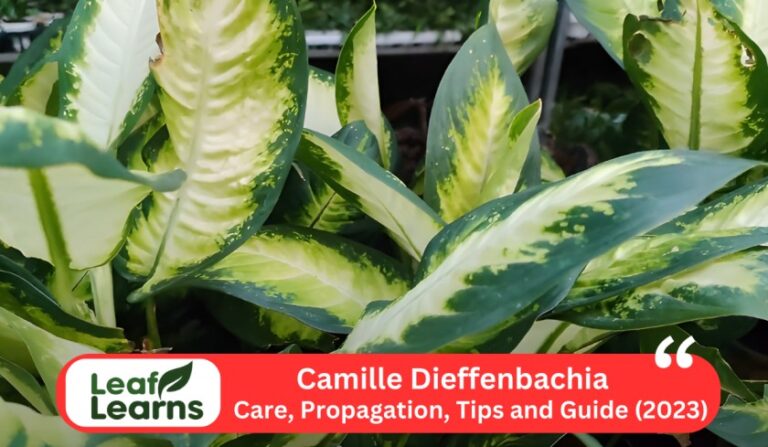Japanese Asplenium nidus fern (Crispy Wave Fern) – Leaflearns (2024)
The Japanese Asplenium nidus fern, commonly nicknamed the Crispy Wave fern, stands out among other ferns for its distinctive ruffled fronds that grow from a central “bird’s nest” rosette, providing a visually appealing textural interest.
These unique zigzag edges in addition to the visually appealing aspect also serve an important function in the plant by increasing the surface area demonstrated in NASA’s air-purifying plant study.
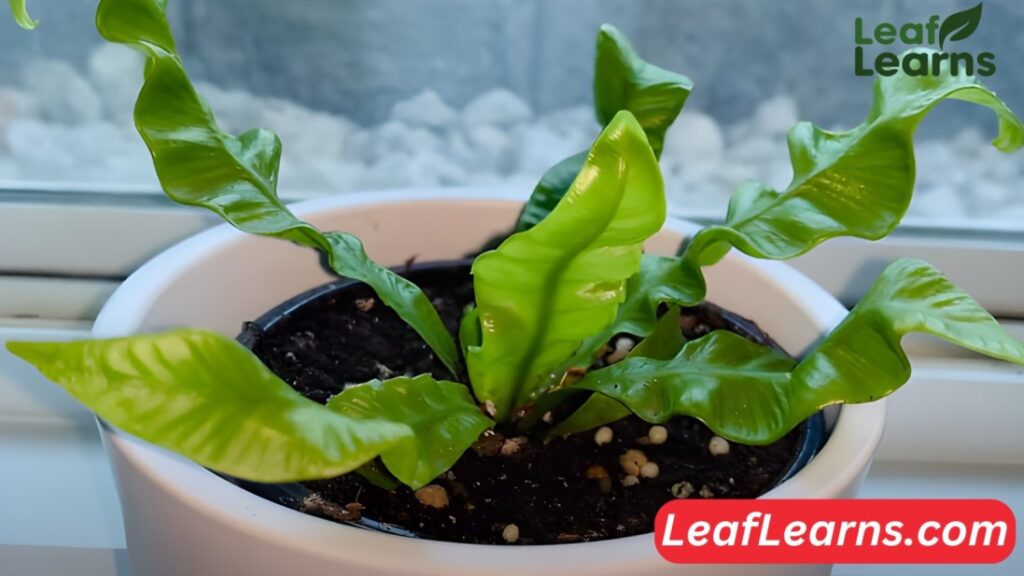
Going further than the well-known Boston Fern in getting rid of harmful particles such as formaldehyde, the Crispy Wave fern is a rival to be reckoned with when it comes to improving indoor air quality.
Likewise, the remarkable property that allows it to grow uninterrupted as long as sufficient area is supplied guarantees that its air purifying capabilities increase with the passage of time.
| Common Name | Crispy Wave Fern, Japanese Asplenium Nidus fern, Pleated Bird’s Nest Fern |
| Scientific Name | Asplenium nidus ‘Crispy Wave’ |
| Family | Aspleniaceae |
| Origin | Japan |
| Plant Type | Perennial fern |
| Size | 18 to 24 inches as a houseplant |
| Lifespan | Several years |
| Leaf Colour | Green |
| Leaf Size | Large |
| Flower | Non-flowering |
| Light | Indirect sunlight |
| Water | Regular watering, keep soil moist but not soggy |
| Soil | Well-draining, rich potting mix |
| Temperature | 60-75°F (15-24°C) |
| Humidity | High humidity, 60-80% |
| USDA Zone | 9-11 |
| Fertilizer | Balanced liquid fertilizer every 2-4 weeks during growing season |
| Propagation | Spores, division of rhizomes |
| Pruning | Remove dead or yellowing fronds |
| Pests | Mealybugs, scale, aphids |
| Toxicity | Non-toxic to humans and pets |
| Uses | Air purification, ornamental plant for indoor spaces |
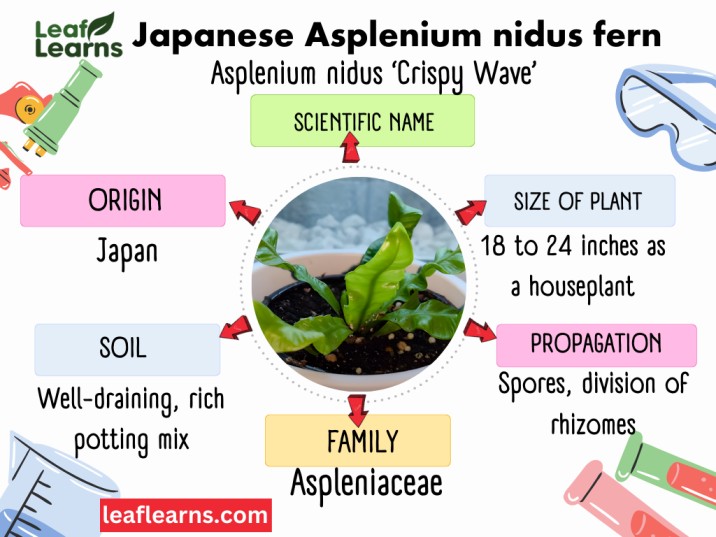
Contents
- 1 Japanese Asplenium nidus fern Care
- 1.1 How much light does a Japanese asplenium nidus fern need?
- 1.2 How often do you water Japanese asplenium nidus fern?
- 1.3 What type of soil is best for Japanese asplenium nidus fern?
- 1.4 Temperature Requirement
- 1.5 Do Crispy Wave Fern like humidity?
- 1.6 How often should I fertilize my Crispy Wave Fern plant?
- 1.7 Potting Requirement
- 2 Japanese asplenium nidus fern Propagation
- 3 Pruning
- 4 How do you repot a Crispy Wave Fern?
- 5 Growth Rate and Size
- 6 Flowering and Foliage
- 7 Appearance and Fragrance
- 8 Pests
- 9 Diseases
- 10 Toxicity
- 11 japanese asplenium nidus fern benefits
- 12 Why is my Crispy Wave Fern turning brown?
- 13 Comprehensive Care Guide for Crispy Wave Fern
- 14 FAQs
Japanese Asplenium nidus fern Care
How much light does a Japanese asplenium nidus fern need?
Picture sunlight filtered through the canopy of a jungle, with dapples. That is the perfect amount of light for your fern. Steer clear of intense sunlight as it may burn the fronds.
Choose indirect, bright light, such as from a window facing east or north. If your windows face south or west, then your only alternatives are to keep the fern farther away or use sheer curtains to screen the light.
You may measure the light intensity using lux meters; try to measure between 10,000 and 20,000 lux.
How often do you water Japanese asplenium nidus fern?
Crispy Wave ferns prefer soil that is regularly damp, but not drenched with water. Imagine more of a cool rainforest shower than a full-on submersion.
When the top inch of soil seems dry, try watering it with room-temperature water. You may need to water more regularly in the summer and less frequently in the winter.
Pay heed to your fern’s cues: brown edges may suggest overwatering, while drooping leaves may indicate thirst.
What type of soil is best for Japanese asplenium nidus fern?
Happy roots require a soil mixture that drains well. To make an airy, moisture-retaining mixture, mix equal parts potting mix, perlite, and orchid bark.
Steer clear of soggy soil as it might cause root rot. To encourage healthy development, repot your fern every 1-2 years into a slightly bigger pot filled with fresh soil.
Temperature Requirement
Your fern will also thrive at a temperature that is cosy and comfy in your living room! Objective: 60–72°F/15–22°C.
Keep it away from drafts, extreme temperature changes, and areas near radiators or air conditioning vents. Recall, happy fern, happy roots
Do Crispy Wave Fern like humidity?
Imagine the mist of a tropical rainforest. Aim for a humidity of 50–80%.
For a moisture-rich microclimate, group your ferns together, use a pebble tray filled with water or acquire a humidifier. Low humidity may be indicated by brown leaf tips; adjust appropriately.
How often should I fertilize my Crispy Wave Fern plant?
Throughout the growth season, your fern appreciates a light diet (spring and summer). Apply a half-strength solution of a balanced liquid fertilizer once a month. In order to prevent straining the plant, do not fertilize in the autumn or winter.
Potting Requirement
In order to avoid waterlogging, choose a pot with drainage holes. Choose a material that promotes adequate air circulation, such as clay or terracotta.
To give your fern ample room for root growth as it develops, repot it into a little bigger pot filled with new soil.
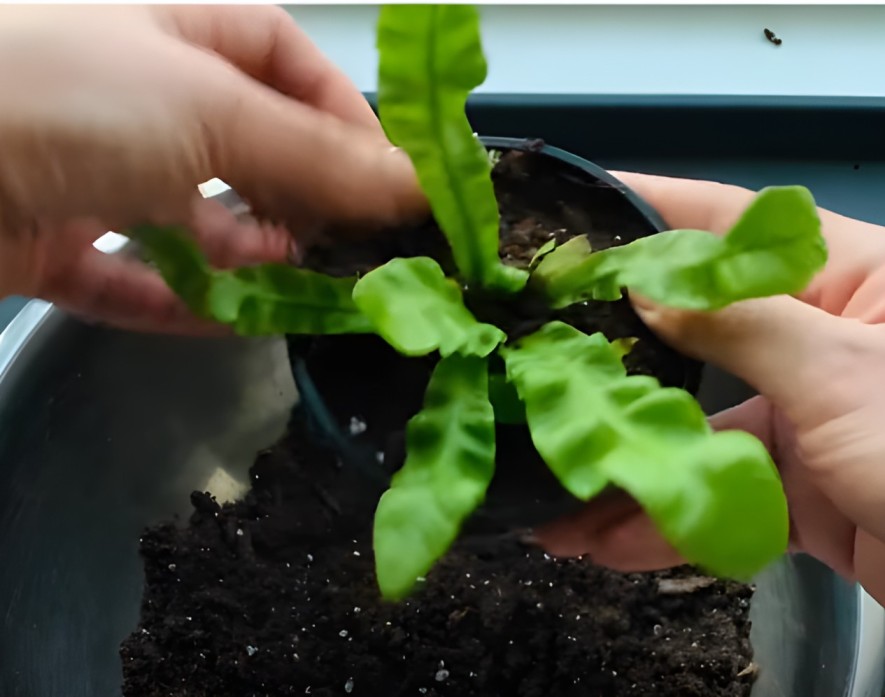
Japanese asplenium nidus fern Propagation
Discover expert techniques and insider tips to ensure your propagation journey is both rewarding and successful.
Division Method
- Choose a mature, robust fern with several fronds to start.
- To reveal the rhizomes, carefully take the fern out of its pot and brush off any extra soil.
- Divide the rhizome into smaller portions, making that each division contains roots and fronds, using a sharp, sterilised knife or pair of scissors.
- As you plant each division, make sure the rhizome is half buried in a separate container of well-draining potting mix.
- Give the recently potted divisions plenty of water, and set them in a warm, damp spot that receives indirect sunshine.
- To promote strong development, keep moisture levels constant and give frequent attention.
- Spore Propagation
- Pick out mature fronds from the parent fern that are loaded with ripe spores.
- To release the spores, place the fronds in a paper bag and let them dry for a few days.
- Get a propagation tray ready and fill it with a sterile, wet blend of perlite and peat moss.
- Evenly scatter the spores across the soil mixture’s surface, then gently push them in.
- Place the tray in a warm, well-ventilated room with indirect sunshine and cover it with plastic wrap or a clear plastic lid to produce a humid atmosphere.
- To keep the soil’s surface damp but not soggy, mist it often.
- Tiny fern gametophytes will start to grow after a few weeks. When they reach the size of little fern plants, move them into separate pots.
Pruning
When to Prune
- Brown or yellow leaves: These might be a sign of ageing, injury, or not enough light. Using sterile shears, cut them off at the root.
- Overgrown Foliage: To improve air circulation and light penetration, trim the outer fronds. Aim for an evenly shaped form.
- Damage from pests or diseases: eliminate impacted areas to stop the spread. Put your fern in isolation if needed.
Pruning Tips
- Less is More. Starting with little parts, prune sparingly. Keep in mind that you cannot remove leaves!
- Clean Cuts: For accurate cuts with the least amount of damage, use sterilized, sharp shears.
- Close the Deal: If the stems are thicker, apply some cinnamon powder to the cut end to promote healing.
How do you repot a Crispy Wave Fern?
The correct pot fosters healthy development, much like a cosy home. Every two to three years, repot your fern; use a pot that is only marginally bigger than the existing one. Select soil that drains effectively and make sure the drainage holes are right. How to do it is as follows:
- Loosen the root ball gently so as not to harm the roots.
- After adding new soil mix to the pot, place the fern inside.
- Wash well and keep an eye out for indications of adjustment stress.
Growth Rate and Size
This fern grows moderately, gaining around 6 to 8 inches a year. Depending on the cultivar and maintenance, it can reach a mature size of one to three feet in height and width.
It may outgrow its pot, which means it has to be replanted, so don’t be alarmed
Flowering and Foliage
The Asplenium nidus is a species of fern that does not produce flowers. However, its enthralling foliage compensates for it.
The fronds, which have wavy edges and a vivid green color, produce an exquisite texture. Their distinctive shape gives any area more visual appeal and air-purifying ability.
Appearance and Fragrance
The rich green colours and architectural design of this fern make it stand out. Its whimsical touch is added by its ruffled texture, which also makes it visually appealing. Its air-purifying properties help create a better indoor atmosphere even if it doesn’t smell.
Pests
- Mealybugs: Sucking sap from plants, these cottony white insects leave behind sticky honeydew and stunted development. Apply neem oil or insecticidal soap to treat.
- Scale: Tiny, protective scales cause yellowing and weakening of leaves. You may either use horticultural oil or scrape them off one by one.
- Spider mites: These tiny vermin cause stippling and webbing on plants and are most active in dry climates. Use insecticidal soap and raise the humidity level.
Diseases
- Overwatering causes rhizoctonia rot, which results in brown, mushy roots and stems. Enhance drainage and eliminate impacted areas.
- Botrytis blight: Grey mould, which causes leaf blotches and wilting, grows best in chilly, moist environments. Boost airflow and get rid of diseased foliage.
Toxicity
The Japanese Asplenium nidus fern is non-toxic to humans So feel free to grow in your home
Is Japanese Asplenium nidus fern toxic to cats and cogs?
Crispy Wave Fern is non-toxic to Cats and dogs, according per the ASPCA Animal Poison Control Centre.
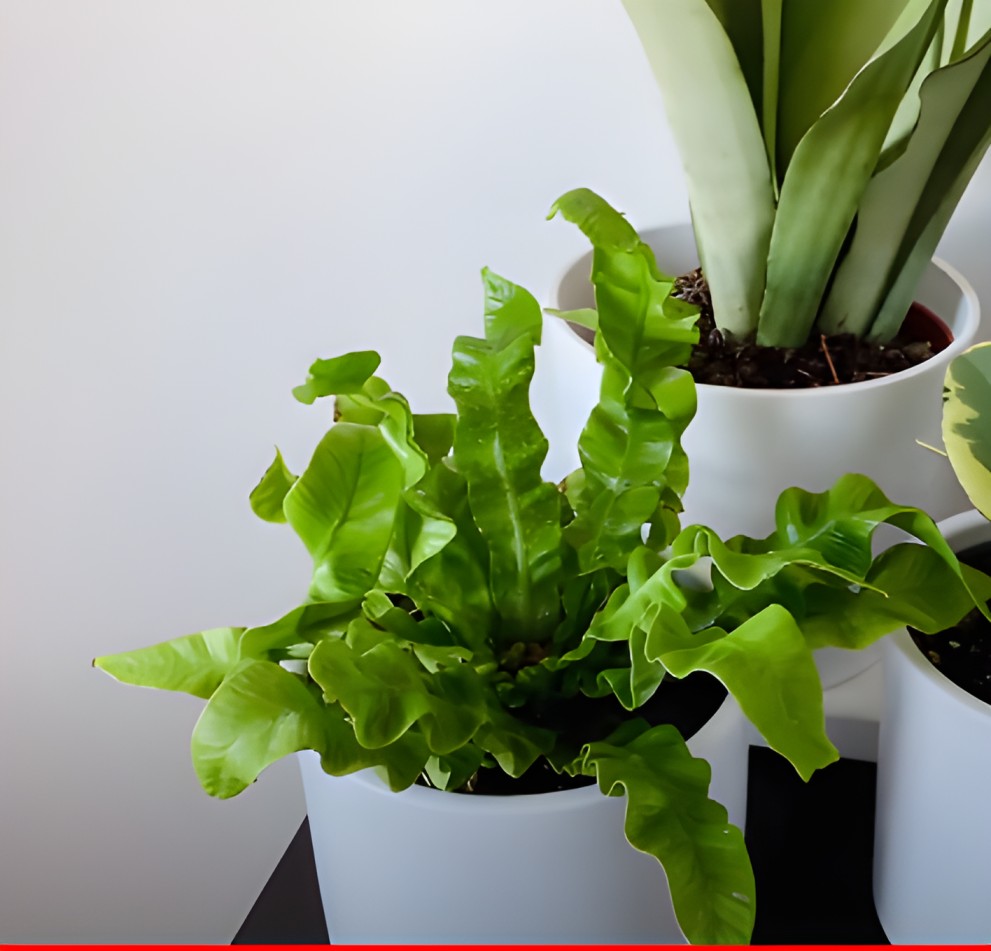
japanese asplenium nidus fern benefits
Air purifier: Take a deep breath! This fern naturally improves indoor air quality by removing pollutants like formaldehyde and volatile organic compounds.
Low Maintenance: These plants are perfect for busy plant parents since they thrive in moderate light and humidity.
Elegant Foliage: Bright green, wavy fronds give any space a rich texture and depth.
Adaptable: For a flexible look, grow them in terrariums, hanging baskets, or on shelves.
Quick-Growing: Take in their beauty right now as these ferns gradually sprout new growth.
Pet-Friendly: You may relax with your animal companions since Asplenium Nidus is safe for both dogs and cats.
Sign of Eternity: Consider adding a fern, which is renowned for its durability and long life, to your house.
Why is my Crispy Wave Fern turning brown?
Though the vivid green foliage of these luxuriant ferns is highly valued, browning might indicate underlying problems.
Examine typical reasons like overwatering, low humidity, or insufficient light, and discover workable fixes to bring back the health and aesthetic appeal of your fern. Use these practical suggestions to keep your indoor haven flourishing.
Comprehensive Care Guide for Crispy Wave Fern
Taking care of a Japanese Asplenium nidus-fern involves several essential steps to ensure its health and vitality. Firstly, understanding the plant’s specific needs, including appropriate lighting, watering frequency, and soil conditions, is crucial.
Regularly checking for signs of distress such as brown tips or pests and diseases is essential for prompt intervention. Additionally, considering the safety of pets like cats is paramount, ensuring that the fern is placed in an area inaccessible to them or choosing cat-safe varieties.
Exploring the diverse varieties and characteristics of the fern, from variegated to golden and crispy wave types, adds an element of personalization to one’s indoor garden.
Language and purchase considerations such as sourcing information in both Japanese and English and selecting the right vendor for purchasing are also important aspects to consider.
Finally, leveraging the fern’s air purifying qualities and incorporating it into home decor, perhaps through unique vase arrangements, further enhances its value beyond mere aesthetic appeal.
FAQs
How do you care for a Japanese nidus fern?
Give it indirect light, moist (not soggy) soil, high humidity, and monthly fertilizer during spring and summer. It thrives in average room temperatures.
Is Asplenium nidus an indoor plant?
Yes, absolutely! It flourishes in well-maintained indoor environments.
What are the benefits of Japanese asplenium nidus fern?
It purifies air, adds lush greenery, tolerates lower light, and is safe for pets.
Is Japanese asplenium nidus fern toxic?
No, it’s non-toxic to humans and pets, making it a family-friendly choice.
Can Asplenium take direct sunlight?
No, direct sunlight can scorch its leaves. Opt for bright, indirect light instead.
What is a fun fact about Asplenium Nidus?
Its wavy edges increase surface area, amplifying its air-purifying abilities!

